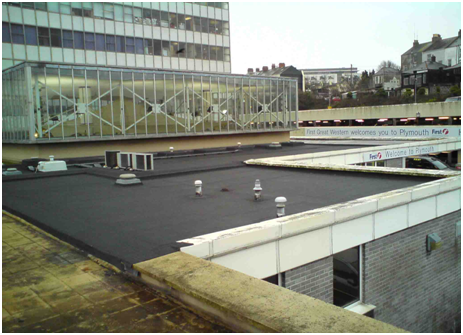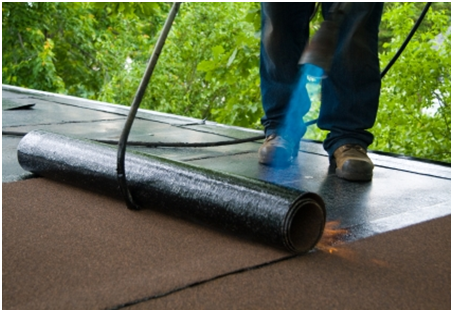Flat Roof
Flat roofs mean the pitch of the roof is either low slope or
100% flat level. We can see flat rooftop buildings
everywhere such as high rise condominium, warehouses,
factory, shopping plaza and school, for residential you only
find them in older communities since new home builders do
not often design flat rooftop homes because of the problems
associated with it. The problem with flat roof is their low
to none slope characteristic, slow rainwater and snow run
off make it more chances to leak and once it starts leaking
it can hardly stop because most flat roof will have pond of
water/snow remaining for a long period of time. That is why
you need to have a real good waterproofing system when it
comes to flat roofing.
There are wide range of materials choices for
flat roofing system, the most popular systems in the market are as
follow:
Built up roof (BUR)/Tar & Gravel
This flat roof system has a history of over 100 years and is
still the most durable and reliable system.
On a hot Built-Up Roof, the
multiple plies are fused together using hot-mopped asphalt
to create a monolithic barrier. Every inch is firmly and
completely adhered over the entire roof area. Each ply of a
Built-Up Roofing system contains a mat of felt paper, glass
fiber, modified bitumen or polyester reinforcement. When
multiple plies are combined and sandwiched between layers of
water-resistant asphalt, the result is a longer. However
this is an expensive system because it takes a complete crew
of roofers and many heavy hot tar equipments to tackle the
job. The average life of a flat roof is 25- 35 years with
hot asphalt.
Single ply membrane roofing
• Modified bitumen flat roofing
Modified Bitumen (MB) roofing is an
asphalt-based, close cousin of the Built-up-Roof (BUR)
designed for buildings
with low-slope or “flat” roof structures.
A two ply roofing
system composed of 2 layers of rubber, a base membrane and a
granulated cap ideally suited for smaller projects, high traffic
areas and roofs used as outdoor living spaces. MB may be
installed by the torch-application method, or “hot-mopped” like
BUR, or applied with “cold-process” adhesives. The best method
to install this material will be heat welded application since
it is meant to be installed this way and it is the heat from the
fame that will melt the membranes to make a 100% watertight
bonding. Also this is more economical than BUR system because it
requires less manpower and no heavy equipments other than a
torch-propane set, it is a favor of many flat roofing
contractors. However, it is the open fame torch application that
bothers a lot of home owner and builders, there has been many
cases of burning down building and homes due to failure of this
application.
• EPDM flat roofing
This is a low cost single ply roofing system composed of a
rubber membrane ideally suited for small or large commercial
and industrial projects. It does not require heat (no open
fame), can be applied using either a fully-adhered glue
system, loose-laid with gravel (ballasted) or mechanically
fastened. Furthermore, it is an environmentally friendly
roof, as it involves reduced emissions from equipment, fewer
petroleum based products, and less waste in landfills. The
drawback with this system is it is relatively vulnerable to
puncture and requires a factory trained installer for a
warranty job.
• PVC roofing
PVC roof
single-ply membrane, featuring fusion-welded seams for
permanent water tightness. This roofing membrane works
extremely well in any environmental conditions providing
reliable roof protection even when your roof is covered with
snow and ice, blazed by strong hail, or covered with ponding
water. The seams are hot air welded creating the permanent
bond that cannot be penetrated even by the standing and
freezing water. In addition it reflects over ninety percent
of solar radiant heat resulting in some very significant
energy savings and keeping your house much cooler than it
would be with conventional roofing membrane. Two common
categories of thermoplastic membrane are Thermoplastic
Olefin (TPO) and Polyvinyl Chloride (PVC). The membrane is
usually produced as a reinforced, white sheet ranging in
thickness from 45 to 80 mils. (thousandths of an inch).





